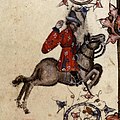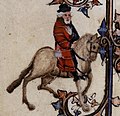| First 18 lines of the General Prologue |
|---|
| Original in Middle English: | Word-for-word translation
into Modern English [14] | Sense-for-sense translation into Modern English
with a new rhyme scheme (by Nevill Coghill) [15] |
|
| Whan that Aprill, with his shoures soote | When [that] April with his showers sweet | When in April the sweet showers fall |
| The droghte of March hath perced to the roote | The drought of March has pierced to the root | And pierce the drought of March to the root, and all |
| And bathed every veyne in swich licour, | And bathed every vein in such liquor, | The veins are bathed in liquor of such power |
| Of which vertu engendred is the flour; | Of whose virtue engendered is the flower; | As brings about the engendering of the flower, |
| Whan Zephirus eek with his sweete breeth | When Zephyrus eke with his sweet breath | When also Zephyrus with his sweet breath |
| Inspired hath in every holt and heeth | Has inspired in every holt and heath, | Exhales an air in every grove and heath |
| The tendre croppes, and the yonge sonne | The tender crops; and the young sun | Upon the tender shoots, and the young sun |
| Hath in the Ram his halfe cours yronne, | Has in the Ram his half-course run, | His half course in the sign of the Ram has run |
| And smale foweles maken melodye, | And small fowls make melody, | And the small fowl are making melody |
| That slepen al the nyght with open eye | That sleep all the night with open eye | That sleep away the night with open eye, |
| (So priketh hem Nature in hir corages); | (So Nature pricks them in their courages); | (So nature pricks them and their heart engages) |
| Thanne longen folk to goon on pilgrimages | Then folks long to go on pilgrimages | Then folk long to go on pilgrimages, |
| And palmeres for to seken straunge strondes | And palmers [for] to seek strange strands | And palmers long to seek the stranger strands |
| To ferne halwes, kowthe in sondry londes; | To far-off hallows, couth in sundry lands; | Of far off saints, hallowed in sundry lands, |
| And specially from every shires ende | And, specially, from every shire's end | And specially from every shires' end |
| Of Engelond, to Caunterbury they wende, | Of England, to Canterbury they wend, | Of England, down to Canterbury they wend |
| The hooly blisful martir for to seke | The holy blissful martyr [for] to seek | The holy blissful martyr, quick |
| That hem hath holpen, whan that they were seeke. | That has helped them when [that] they were sick. | To give his help to them when they were sick. |


























